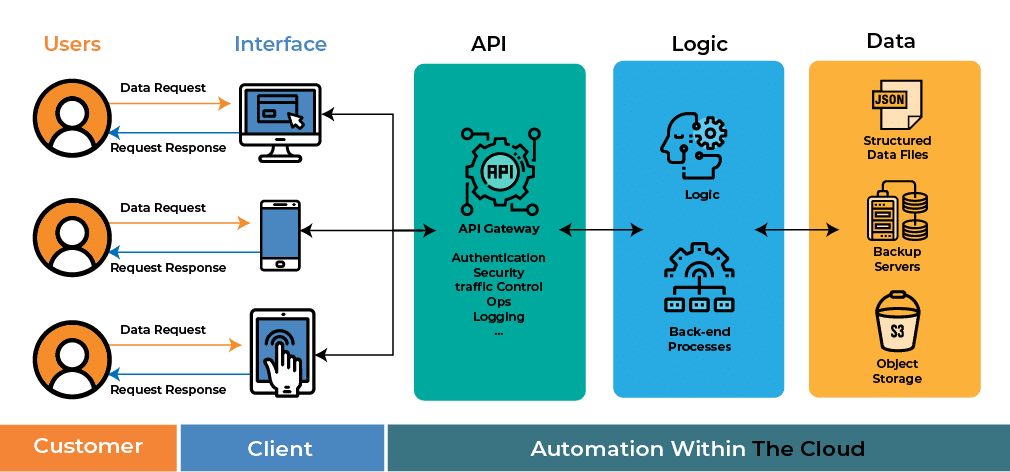Using API Data integration as a tool for data integration can help you build a more connected workflow. Pass data easily and automate difficult workflows with custom build back end processes (BEPs) and APIs.
WHAT IS AN API?
Making Complex Processes Simple
Whether we are aware of it or not, APIs are a huge part of how we interact with technology on a daily basis. Many of the applications and interfaces we use are highly dependent on APIs to find information and simplify complex processes. They serve as bridges, connecting programs, workflows, and data together so it can be more effective. APIs do four primary things:
Streamline Data Access
APIs are effective tools for locating data for the user even when it resides in a different database, application, or program. Many popular applications are essentially portals into deeper databases of information. Content streaming services, weather apps, and more all use APIs help users access complex data.
Reduce Complexity
APIs can serve as shortcuts, shielding the user or developer from complexity by calling out to pre-built processes or code. For example, a developer doesn’t need to understand how satellites or positioning algorithms work in order to build an application that has GPS tracking. APIs can be used to connect their application to a more complex GPS system.
Enhance Functionality
In addition to reducing complexity, APIs can add new functionalities to software, portals, and apps. APIs can abstract more complex code in the background or bridge to disparate applications so that they can easily pass data back and forth.
Improve Data Security
APIs can serve as gatekeepers – controlling application access and informing the user of what application a program is using. When following best practices, APIs can be a useful tool in protecting sensitive information from both active and passive threats.
Making the World More Connected
How API Data Integration Works
Building API integration into your application or workflow allows you to make the most of your data by employing it where it will be most useful. Whether this means using it for analytics or as content within your software or applications, integration keeps you connected to your business information.

REST API
What is Unique about REST API?
REST stands for Representational State Transfer. Where a regular API is a essentially a set of functions that allow communication between applications, a REST API is a architectural style for connected applications on the web.
A REST API is usually considered industry standard when building web APIs because it is simpler, more flexible, and uses existing protocols such as HTTP. REST API are especially popular for building mobile and cloud applications because of its superior scalability, automation, and simplicity in action.
DATA INTEGRATION AT WORK
Use Cases for Data Integration
Data Integration has the power to connect you to your information. DOMA can guide you in connecting your structured data into your cloud application or into a business intelligence tool such as Microsoft Power BI or AWS QuickSight. Incorporating API Integration into your workflow can help your organization:
- Cloud integration connects cloud and on-premise applications for improved functionality
- Support enterprise-wide projects such as disaster recovery, information collaboration, web services, or security and compliance
- Map, track, and display important data
- Eliminate or reduce data silos
- Make your application or service(s) more competitive
Three Basic Tips for Securing your APIs
Contact Us
For more information on Hyper Automation with DOMA please contact:




